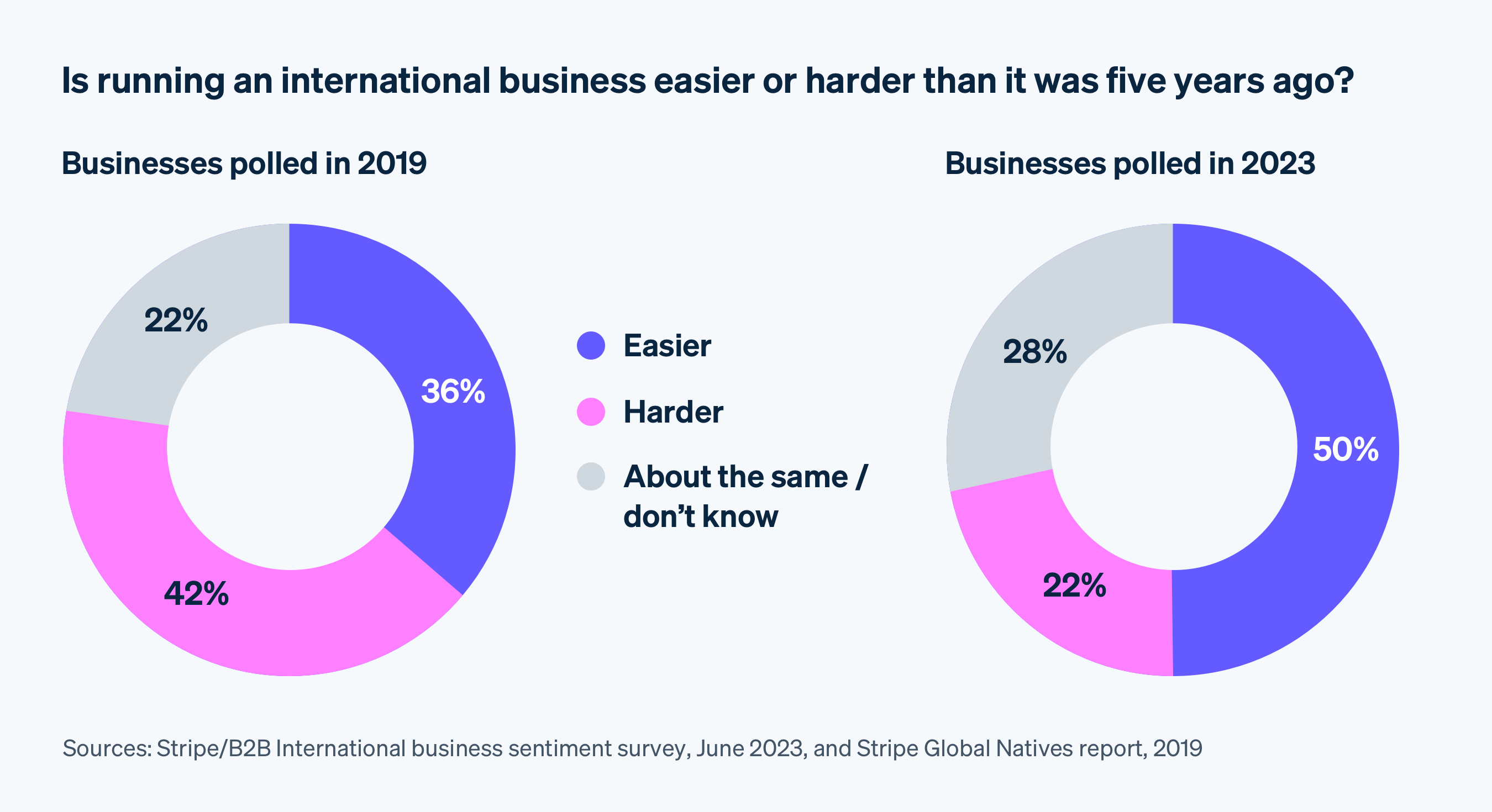Stripe report finds businesses are racing across borders with digital trade
- Sixty-six percent of businesses are gearing up to sell to new countries in the next two years.
- Half of businesses say it’s easier to sell internationally than ever, despite current geopolitical challenges.
- While near-neighbor exports remain high, trade routes between “unusual suspects” are growing. All countries studied are now exporting at scale to multiple continents.
- Microbusinesses are going international, with 80% of solo entrepreneurs selling to multiple countries.
SAN FRANCISCO AND DUBLIN—Stripe, a financial infrastructure platform for businesses, today published a report showing striking confidence and investment in digital exports, beyond typical trade routes. It finds that a wide cross section of businesses are planning ambitious expansion into new international markets, from the largest enterprises to solo entrepreneurs, and that digital trade routes are becoming significantly more diversified, as companies respond opportunistically to demand wherever in the world it appears.
The findings emerged from analysis of aggregated transaction data on the Stripe platform as well as surveys with 1,700 business leaders and 11,500 consumers across nine global markets: Australia, France, Germany, Ireland, Japan, Mexico, Singapore, the UK, and the US. The Stripe report reveals that technology is remaking established patterns of globalization and that digital tools are enabling businesses of any size to sell to customers anywhere on the globe.
Businesses and consumers are optimistic about the globalized economy
Despite macroeconomic and geopolitical challenges, businesses and consumers are increasingly enthusiastic about buying and selling abroad. The report finds that 66% of businesses are planning to expand internationally within the next two years, while 81% expect to increase their international sales over the next five years.

These plans are supported by technology that has made cross-border commerce easier. Global trade is operationally complex and requires localized market expansion strategies. These are hard challenges for any business to solve on its own. But the proliferation of easy-to-use digital tools for accepting payments, managing inventory, and fulfilling tax obligations now means businesses don’t have to. Fifty percent of businesses surveyed said they think it is easier to run an international business today than it was five years ago. Only 22% think it’s become harder.

As businesses look abroad, international consumers are waiting for them. Sixty-eight percent of consumers are open to buying physical goods and 59% are open to buying digital services from a company based in another country. The numbers are even higher among consumers ages 18–34: 76% said they’d buy physical goods and 74% said they’d buy digital services cross-border.
A surprisingly wide range of industries benefit from digital trade
The report finds that 81% of sole proprietor businesses now sell to more than one market, while 18% sell to more than 11 global markets. At the same time, traditional enterprises are leaning into cross-border expansion too, with the number of enterprises selling internationally on Stripe increasing 31% last year. And they see room to run. Fifty percent of larger enterprises surveyed said they plan additional international expansion in the next two years.

Digital trade is boosting more than just software businesses and ecommerce sites. Education has traditionally been an offline industry, with companies tied closely to their home markets, but that’s changing rapidly. Eighty-eight percent of education businesses sell internationally today, and 70% plan to expand into new countries in the next two years.
Digital trade routes are diversifying
Fastest-growing digital exports markets based on Stripe transaction data, 2021–2022
While many of the fastest-growing digital trade routes are between neighboring countries, there are striking exceptions. Australia and Ireland have a burgeoning trade relationship, starting from a relatively small base and driven by travel and tourism. In 2022, Ireland was the fastest-growing digital export destination for Australian businesses, based on Stripe transaction data. Germany, meanwhile, led as the fastest-growing digital export destination for US businesses in 2022.
These trends are pervasive. The top five digital export destinations for businesses in France, Germany, Ireland, and Japan include countries on two continents. The top export markets for businesses in Australia, Mexico, Singapore, the UK, and the US include countries on three continents.
“Digital trade is creating opportunities for businesses to expand their total addressable markets, but success never comes easily,” said Mike Clayville, chief customer officer at Stripe. “Businesses need simple financial infrastructure that just works, no matter where they sell to. Our findings show businesses are increasingly taking advantage of this potential—and that’s something to celebrate.”
Read the full report here.

